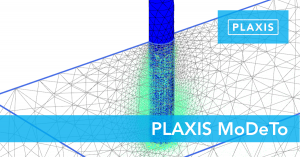Discover the new PLAXIS MoDeTo
October 17th, 2018
The newly-developed PLAXIS MoDeTo constitutes the most innovative solution for the design of laterally-loaded monopile foundations. PLAXIS MoDeTo transfers the results of the PISA joint industry research project to daily engineering practice, extending the conventional design approach to accurately model the response of large diameter monopile foundations for offshore wind turbines.
 Optimised for monopile foundations
Optimised for monopile foundations
More than 80% of existing offshore wind foundations are monopiles. In spite of this prominence, the conventional design approach in use (p-y method) has been largely disputed, and has been shown to lead to over-conservative designs. This method was created for long and slender foundation piles and only takes into account horizontal soil reactions along the shaft. The main alternative, 3D FE analysis, is computationally too demanding for the thousands of load cases contemplated in offshore engineering. The PISA method addresses these shortcomings by introducing a pile model that does not depend on slenderness assumptions and also considers shaft shear and base reactions. These are most relevant as the diameter grows larger with respect to the pile length, as it is the case for monopile foundations, leading to a significant optimisation in structural dimensioning.
Innovative, reliable, tested
PLAXIS MoDeTo has been developed by Plaxis in collaboration with the PISA Academic Work Group, drawn from University of Oxford, Imperial College London, and University College Dublin, and Fugro, an expert designer of offshore wind foundations. Its implementation has been validated using both 3D FE models and experimental results from the PISA field tests at Dunkirk, France, and Cowden, United Kingdom. Future research related to PISA (e.g. PISA2) will also be implemented in PLAXIS MoDeTo.
Advance your design practice
The p-y approach has undergone little change since its development in the 1970s. Its application is limited to generic rule-based (p-y) soil reaction curves, validated for a narrow range of geometries and soil types. This has led the same industry-wide standards that recommend using this method to also prescribe the need for numerical 3D FE validation. While PLAXIS MoDeTo enables the conventional rule-based approach, it also implements an automated workflow for a numerical-based methodology. Under the latter, site-specific soil reaction curves are calibrated using the actual soil characteristics from a small set of PLAXIS 3D FE models that define the project design envelope. This allows specific, precise, soil reaction curves that accurately model the site soil conditions and geometry space of the project. It also provides a means of advancement towards a global database of project-specific soil curves. Further improvements in numerical methods or constitutive models will enrich this database and enhance existing soil reaction data sets.
Drive down costs right at the foundation
Foundations amount to 20-30% of capital costs of offshore wind. Through realistic modelling of the pile-soil interaction, PLAXIS MoDeTo enables dramatic reductions in the embedded length of each monopile in an offshore wind farm. Optimising the amount of steel per monopile leads to further savings in fabrication time and cost; logistics and handling operations; installation time, cost and risk; and environmental impact. Leverage the enhanced PISA design method and start realising XXL savings today.
Fast 1D iterations with the accuracy of full 3D
PLAXIS MoDeTo employs a robust and highly-efficient 1D FE solver to model the behaviour of the embedded monopile under lateral loading. It makes use of Timoshenko beam theory to account for shear deformations, while the soil response is captured through a set of soil reaction curves (under the PISA method: distributed load, distributed moment, base shear, and base moment), either user-defined (rule-based design) or calibrated from a set of PLAXIS 3D models (numerical-based design). Thus, design iterations for multiple geometries and load cases can be run in seconds rather than in hours. An excellent match is obtained between numerically-calibrated 1D and full 3D results.
 Integrate seamlessly with PLAXIS along the whole project lifecycle
Integrate seamlessly with PLAXIS along the whole project lifecycle
Use PLAXIS MoDeTo either as a stand-alone application when defining the soil reaction curves (rule-based design) or in connection with PLAXIS 3D to extract them numerically from geotechnical 3D models (numerical-based design). At concept and preliminary design stages, rule-based curves can be defined via generalised formulation, extracted from the literature or industry standards, order-of-magnitude calibrations, or using data from similar projects. As more detailed site investigation and soil testing data are obtained, a design envelope of 3D FE models with advanced constitutive models can be employed for the numerical calibration of high-quality soil reaction curves, which can then be used to fine-tune the final design. The interlink between PLAXIS MoDeTo and PLAXIS 3D easily automates the process of generating and calculating the 3D models; deriving, normalising and parameterising the soil reaction curves; and their extraction to the 1D model. Once a valid design is attained, it can easily be re-created in PLAXIS 3D for any additional checks and verifications.
Take the most out of PLAXIS MoDeTo with PLAXIS 3D 2018
PLAXIS is used worldwide by top engineering companies and institutions in the civil and geotechnical engineering industry on projects that range from excavations, embankments, and foundations to tunnelling, mining, and reservoir geomechanics. The recently released PLAXIS 3D 2018 is a powerful, well proven and robust finite element package capable of tackling even the largest and most complex geotechnical models. Combine the potential of PLAXIS MoDeTo and PLAXIS 3D for the most complete solution for the geotechnical analysis and design of monopiles and any other type of offshore wind foundation.
To learn more about how PLAXIS software can help you or to arrange an upgrade, please call 0161 474 6886 or email info@WildeAnalysis.co.uk.
